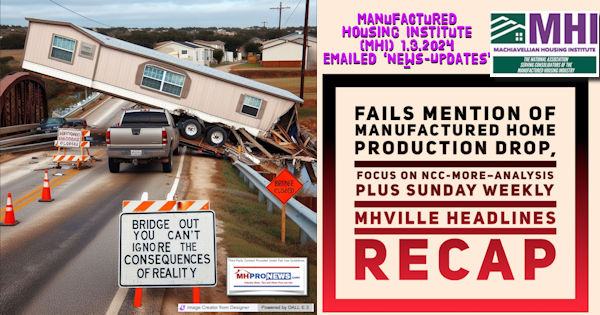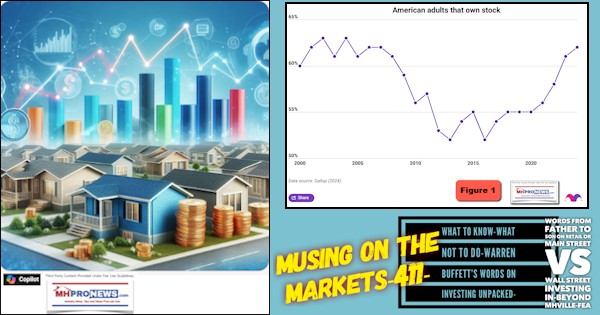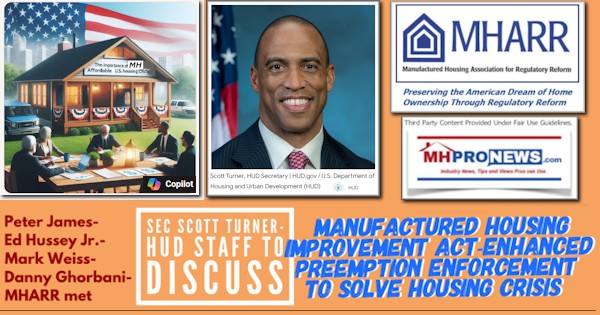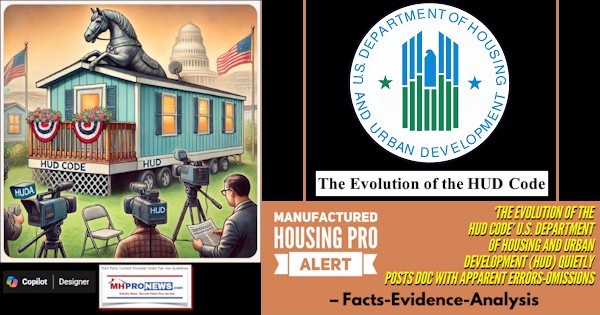
The U.S. Department of Housing and Urban Development (HUD) has apparently recently and quietly issued a document they named “The Evolution of the HUD Code.” To the underinformed it would look to be a history in brief of the “evolution” of the HUD Code for manufactured housing. However, the document appears to have some errors and significant omissions that should call into question the agency’s motivation for publishing the document in the first place. For example, the timing of this document being published prior to the Trump Administration coming back into office given media reports that Biden-Harris (D) era agencies and federal officials are taking steps to “Trump proof” the federal bureaucracy that may have acted unconstitutionally and/or inappropriately with respect to their Congressional mandate. This document curiously appears to have emerged after the time that the most recent report about the evolution of mobile homes into manufactured homes by Federal Reserve system linked researchers Elena Falcettoni, James A. Schmitz Jr., and Mark L. J. Wright was published, which ought to be questioned and along with the motivations for this document.
Perhaps more subtly, the document has appeared after MHProNews, MHLivingNews and articles published on the Patch and elsewhere has aimed to draw attention to failures by HUD to properly implement the changes made federal law by the Manufactured Housing Improvement Act of 2000 (a.k.a.: MHIA 2000, MHIA, 2000 Reform Act and 2000 Reform Law). There is only one use of the word “preempt” which is actually HUD’s use of the word “preemptive.” So-called “enhanced preemption” as made law by the 2000 Reform Act is entirely ignored.
Missing is any mention of the 2003 letter to HUD Secretary Mel Martinez (R) by Democratic lawmakers acting in their oversight role who helped pass the 2000 Reform Law and clearly explained their view of what “enhanced preemption” should mean.
Also ignored in this apparent ‘history’ as viewed through the eyes of HUD is the fact that Congress held two regulatory oversight hearings in 2011 and 2012 that often revolved around the failure of HUD to enforce “enhanced preemption.” Note that those hearings included representatives who are members of the Manufactured Housing Association for Regulatory Reform (MHARR) and the Manufactured Housing Institute (MHI).
Missing too is the Innovative Housing Showcase (IHS) launched during the term of HUD Secretary Ben Carson, M.D. to draw more attention to HUD Code manufactured homes and other types of ‘innovative’ housing.
Missing is a Congressional hearing when HUD Secretary Marcia Fudge (D) was questioned by a Representative about enhanced preemption, and Fudge flatly refused to enforce that provision of the law.
Missing is a reference to the remarks made by Cavco Industries’ William “Bill” Boor on 7.14.2023 when Boor called on Congress in a public testimony to enforce enhanced federal preemption.
While it is possible that these and other omissions are all coincidental and were conceivably innocent mistakes, they are nevertheless important parts of the reason why HUD exists and are pivotal in why HUD’s role in manufactured housing. Manufactured housing is apparently being thwarted in the industry’s potential to solve the affordable housing crisis that could provide potentially millions of affordable homes to consumers who need affordable housing that includes minorities. Restated, these harm consumers and thus industry growth.
Not to be overlooked, the issues that collectively are causing a multi-million-unit shortage of affordable housing which is costing the U.S. economy an estimated $2 trillion dollars per year in lost Gross Domestic Product (GDP). That estimate on the economic harm caused from a lack of affordable/manufactured housing is per MHI member Cavco Industries (see bottom right of Cavco illustration linked here), Senator Sheldon Whitehouse (RI-D) – see his press release linked here – and other sources.
The list above is not meant to be exhaustive, but rather to focus on some of the more significant elements of the apparently missing and omitted history.
Some added information will follow the WORD converted version of the HUD PDF, which is linked here and on the HUD website. MHProNews is hereby calling on HUD to remove this document and make necessary corrections before reposting it. Those corrections should be provided to MHI and MHARR for approval before being published to insure that some other relevant historic items aren’t overlooked.
Note that yellow highlighting is added below by MHProNews on one item that is an apparent typo, it appears it should be 1988 not 1998.
Part I – PDF of Word Conversion version of the following from the HUD website is linked here on MHProNews and here on the HUD website.
The Evolution of the HUD Code
Throughout its five decades, the HUD Code has and will continue to evolve to meet the needs of those seeking manufactured housing as a comparable alternative to traditional site-built homes:
1974: The National Manufactured Housing Construction and Safety Standards Act of 1974 is passed, directing the HUD Secretary to establish national manufactured housing construction and safety standards and regulations for the country, commonly referred to as the “HUD Code.”
1976: The first version of the HUD Code is implemented. From this point on, all manufactured homes constructed in the United States are required by federal law to be built in compliance with the nationally preemptive HUD Code standards.
1984: The first-ever government issued formaldehyde emission limits for plywood and particleboard are issued by HUD and fire safety improvements are added to the HUD Code (49 FR 31996).
1987: HUD Code updates incorporate reference standards, utility entrance requirements (52 FR 4574), and enhanced testing for windows and doors (57 FR 35542).
1998: Standards requiring lead-free water piping in manufactured homes are added (53 FR 23610).
1990: Congress establishes the National Commission of Manufactured Housing to develop recommendations for modernizing the National Manufactured Housing Construction and Safety Standards Act of 1974.
1993: HUD upgrades energy conservation requirements in the HUD Code (58 FR 58204) with more rigorous thermal values and house ventilation requirements.
1994: In response to the devastation caused by Hurricane Andrew, HUD significantly strengthens the HUD Code wind standards to enhance the structural integrity of manufactured homes.
2000: The Manufactured Housing Improvement Act of 2000 (2000 Act) is passed. This legislation significantly amends the 1974 Act by creating new mandates for manufactured home installation and dispute resolution, requiring that the Secretary of HUD establish the Manufactured Housing Consensus Committee (MHCC). The MHCC is a Federal Advisory Committee, charged with providing recommendations to the Secretary on the revision and interpretation of HUD’s manufactured home construction and safety standards and related procedural and enforcement regulations.
2002: HUD updates the HUD Code to revise the location and placement of smoke alarms for increased safety and effectiveness.
2005: HUD publishes the first major revisions to the HUD Code via the federal rulemaking process (70 FR 72024) that are based upon the first set of MHCC recommendations for HUD Code updates. These revisions addressed a wide range of revisions including areas of fire safety, roof load and design requirements, and thermal protection.
2007: HUD establishes the Manufactured Housing Dispute Resolution Program which provides timely resolution of disputes between manufacturers, retailers and installers of manufactured homes regarding responsibility, and for the issuance of appropriate orders for the correction or repair of defects in manufactured homes.
2008: HUD establishes the Manufactured Home Installation Program which ensures that minimum installation standards and installation programs are in place and operating in all states.
2009: HUD strengthens its oversight of quality assurance implementation to emphasize quality and focus on improving quality control procedures and quality assurance programs within the manufactured housing industry.
2013: HUD publishes its second revision to the HUD Code based upon the second set of MHCC recommendations (78 FR 73966). The standards address a wide range of revisions including areas of testing, plumbing, heating and cooling, and electrical systems.
2014: HUD implements revisions to “Subpart I” requirements of the Manufactured Home Procedural and Enforcement Regulations, establishing new processes for manufacturers to handle consumer complaints and report problems.
2015: Based upon recommendations from the MHCC, HUD implements on-site completion of construction requirements, and associated procedures, for manufactured homes. Effective in 2016, the regulations addressed manufactured homes that are substantially completed at the installation site.
2020: HUD issues two final rules to address formaldehyde emission standards (85 FR 5562) and adjust minimum payments to States (85 FR 71831), strengthening HUD’s commitment to State Administrative Agencies – its regulatory partners.
2021: HUD publishes a major revision to the HUD Code based upon the third set of MHCC recommendations (86 FR 2496), including changes to carbon monoxide detector requirements, attached garages and carports, zero lot line homes, and other safety and construction innovation improvements. In addition, HUD issues first-ever industry-wide Alternative Construction letters for doors, windows, and circuit breakers to support continued industry construction of manufactured homes amidst supply chain constraints due to the COVID-19 pandemic.
2022: HUD proposes the largest revision to the HUD Code based upon the fourth and fifth sets of MHCC recommendations, including the incorporation of over 80 new or updated reference standards into the HUD Code, standards supporting multi-dwelling unit single family manufactured homes, facilitating more open floor plans, integrating more innovative ridge roof designs, facilitating use of energy-saving appliances, and other improvements.
2023: The Office of Manufactured Housing Programs becomes an independent office within the Office of Housing at HUD, to be led by a Deputy Assistant Secretary for Manufactured Housing Programs reporting directly to the Assistant Secretary for Housing and Federal Housing Commissioner.
2024: The HUD Code celebrates its 50th anniversary. As HUD releases its largest update to the HUD Code in over two decades, it renews its commitment to promote and preserve the quality, durability, safety, and affordability of manufactured homes nationwide.
—
Part II – Additional Information with More MHProNews Analysis and Commentary
1) In no particular order of importance are the following items to consider with respect to the apparent problems raised in the preface of this article regarding the arguably flawed HUD issued history of manufactured housing’s “evolution.”

2) According to Senator Sheldon Whitehouse (RI-D) is the following.
Nationwide, the shortage of affordable housing opportunities costs the American economy an estimated $2 trillion each year. High housing costs reduce disposable income and economic mobility, stifling economic opportunities.
3) The Q&A and with left-leaning Bing’s artificial intelligence (AI) powered Copilot chat confirms that HUD posted this after the evolution of mobile homes into manufactured homes by Federal Reserve system linked researchers Elena Falcettoni, James A. Schmitz Jr., and Mark L. J. Wright was published in September of 2024.

4) Follow ups to the above chat (Q&A) with Copilot revealed the following.
Regarding that same HUD PDF https://www.hud.gov/sites/dfiles/PA/documents/The-Evolution-of-the-HUD-Code.pdf it appears to have an error in a date (1998: Standards requiring lead-free water piping in manufactured homes are added (53 FR 23610) – that should be 1988, right?) and it appears to omit several important developments with respect to the Manufactured Housing Improvement Act of 2000, such as a mention of the enhanced preemption provision of the law, the letter in 2003 from Democratic Lawmakers to then HUD Secretary Mel Martinez that stressed enhanced preemption needed to be enforced, hearings held in 2011 and 2012 regarding failure to get enhanced preemption routinely enforced, and the launch of the Innovative Housing Showcase under HUD Secretary Ben Carson, and other related federal preemption items, doesn’t it?

Regarding the Manufactured Housing Improvement Act of 2000, you’ve highlighted some significant omissions. The enhanced preemption provision is indeed a crucial aspect, and the 2003 letter from Democratic lawmakers to then HUD Secretary Mel Martinez emphasized the need for its enforcement. The hearings in 2011 and 2012 also underscored the ongoing challenges in enforcing this provision. Additionally, the Innovative Housing Showcase launched under HUD Secretary Ben Carson was an important initiative to promote innovative housing solutions.
It seems like there’s a lot more to the story that could be included in the document. Do you think these omissions might affect the overall understanding of HUD’s evolution?

5)
Can you find any evidence that HUD has publicly responded to the research published in September 2024 by Federal Reserve linked researchers Elena Falcettoni, James A. Schmitz Jr., and Mark L. J. Wright that claims that HUD is in part response for the ‘sabotage’ of the emergence of mobile homes into manufactured homes by essentially colluding with the National Association of Home Builders (NAHB) by giving conventional housing subsidies to help them compete against the emerging manufactured home industry, and other steps they say harm access to affordable manufactured housing?

Given that a lack of affordable housing in the U.S. has been said to cause a $2 trillion dollar a year economic drag on our economy, and since HUD is tasked with being the primary regulatory of HUD Code manufactured housing, aren’t the claims made by Elena Falcettoni, James A. Schmitz Jr., and Mark L. J. Wright and other critics of HUD important to address and resolve?

HUD’s role as the primary regulator of manufactured housing makes it essential for them to respond to these criticisms and ensure that their policies support, rather than undermine, the availability of affordable manufactured homes. This is especially important given the reliance on chattel loans for financing manufactured homes.
Would you like me to keep looking for more information or help with something else? …”
7)
While there are numbers of critics such as MHARR, Frank Rolfe, MHProNews, MHLivingNews, et al of the Manufactured Housing Institute leaders in the 21st century for purported conflicts of interest, apparently working to benefit consolidators, and an array of legal issues that face some higher profile members, isn’t it fair to say that in the ideal, HUD should be doing their job properly with or without an association pushing them to act according to Congressional intent, isn’t that correct? Confirm, clarify or correct as needed and link the results.

However, criticisms from organizations like MHARR and individuals such as Frank Rolfe highlight concerns about potential conflicts of interest and the effectiveness of HUD’s actions. These criticisms suggest that there may be areas where HUD could improve its performance to better align with Congressional intent and support the affordable housing market.
Would you like more information on any specific aspect of this issue?
The screen capture of the above Q&A is shown below.

8) MHProNews plans to follow up with federal and association officials on this topic. Until then, to better understanding the importance of the ignored issues are the following linked reports.









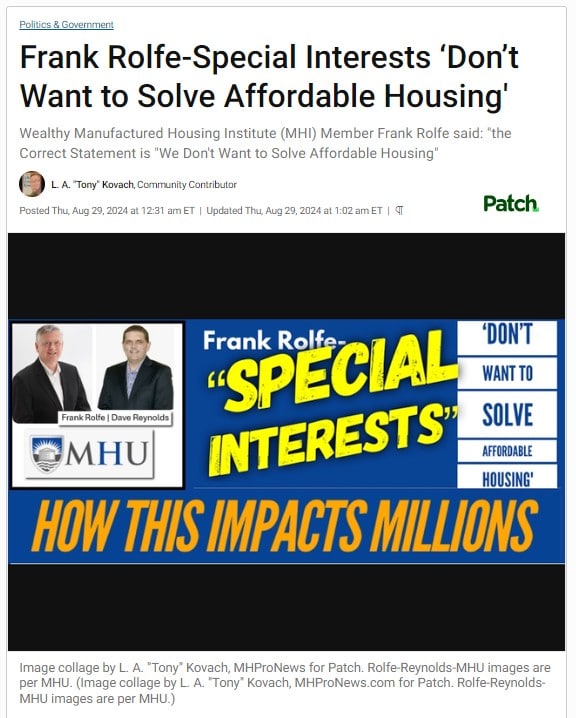

















Again, our thanks to free email subscribers and all readers like you, as well as our tipsters/sources, sponsors and God for making and keeping us the runaway number one source for authentic “News through the lens of manufactured homes and factory-built housing” © where “We Provide, You Decide.” © ## (Affordable housing, manufactured homes, reports, fact-checks, analysis, and commentary. Third-party images or content are provided under fair use guidelines for media.) See Related Reports, further below. Text/image boxes often are hot-linked to other reports that can be access by clicking on them.)

By L.A. “Tony” Kovach – for MHProNews.com.
Tony earned a journalism scholarship and earned numerous awards in history and in manufactured housing.
For example, he earned the prestigious Lottinville Award in history from the University of Oklahoma, where he studied history and business management. He’s a managing member and co-founder of LifeStyle Factory Homes, LLC, the parent company to MHProNews, and MHLivingNews.com.
This article reflects the LLC’s and/or the writer’s position and may or may not reflect the views of sponsors or supporters.
Connect on LinkedIn: http://www.linkedin.com/in/latonykovach
Related References:
The text/image boxes below are linked to other reports, which can be accessed by clicking on them.’






